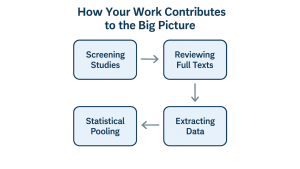7 Summary: How Your Work Contributes to the Big Picture
What You’ve Learned So Far
By this point, you’ve walked through the core stages of conducting a meta-analysis:
-
Screening studies to identify which ones matter
-
Reviewing full texts to confirm their eligibility
-
Extracting data to build a structured, analyzable dataset
-
Understanding key concepts like effect sizes, confidence intervals, heterogeneity, and weighting
-
Preparing for statistical pooling using transparent, replicable methods
You’ve gained skills in critical reading, evidence evaluation, data handling, and collaborative research—and you’ve contributed to a meaningful, real-world project.
Why This Project Matters
Air pollution isn’t just a global environmental problem—it’s a reproductive justice issue.
PM₂.₅ exposure during pregnancy has been linked to devastating outcomes like preterm birth and stillbirth. But most of what we know comes from high-income countries. Our project centers low- and middle-income countries (LMICs), where both exposure and vulnerability are higher—and where the evidence is urgently needed to inform policy and protect lives.
By helping us identify, extract, and organize this evidence, you’re making it possible to:
-
Reveal global patterns that individual studies can’t detect
-
Highlight data gaps that need to be filled
-
Contribute to a publication that may influence real-world action
Your Piece in the Puzzle
At times research can be tedious and it may feel like you are just copying and pasting a number for a row for a paper. But that one row becomes a point on a forest plot. And that point, combined with others, helps build a body of evidence that has scientific, clinical, and policy-level relevance.
Media Attributions
- Untitled design (2)

